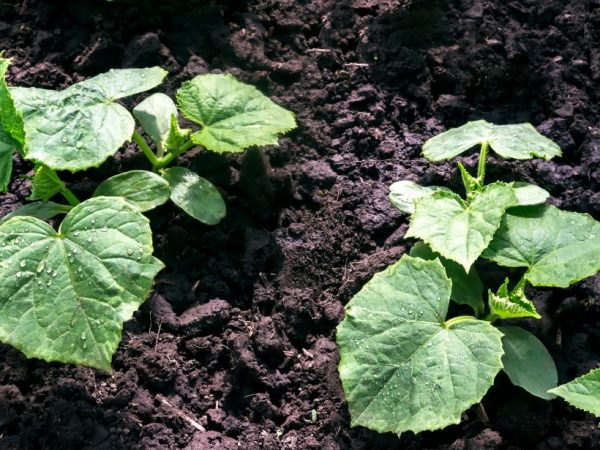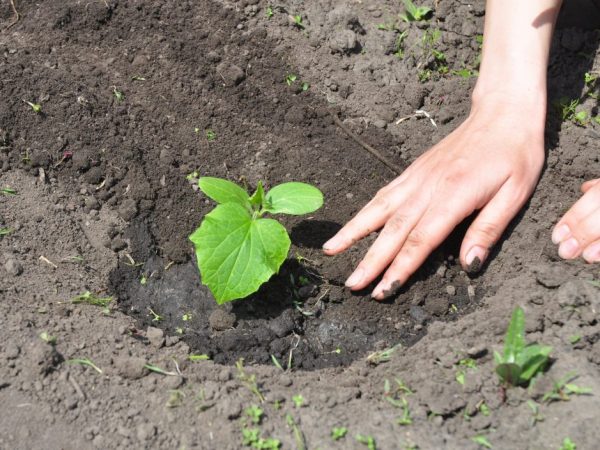Rules for planting cucumbers in open ground
Planting cucumbers in open ground requires compliance with certain temperature conditions and basic rules of agricultural technology. It can be produced by seeds or seedlings, taking into account the characteristics of each method. Consider how and when to plant cucumbers in open ground using sowing or seedling planting methods.

Rules for planting cucumbers in open ground
Features of planting in open ground
Temperature
For planting cucumbers in open ground, it is necessary that the ground temperature warms up to at least 16-17 ° C. Cucumbers are a thermophilic plant that grows reluctantly at low temperatures and often dies. In different regions, the required temperature is set at different times: in spring or summer, from the second half of May to the first decade of June.
It is the temperature of the earth (and not the air) that needs to be measured at a depth of about 7-10 cm.
Drop off time
Sowing cucumber seeds in open ground is most often done on the 20th of May, provided that the soil has warmed up well enough. Sowing seedlings in pots is done 2-3 weeks before the time of planting seedlings in the ground - at the end of April or at the beginning of May. If you are planting seedlings in the ground in early spring (from mid-May), you can cover the bed with plastic wrap. Seedlings planted in the ground in early June usually do not need additional shelter.
The ripening period of the culture is on average 40-45 days (depending on the variety and climate), so in summer it is necessary to sow no later than the second half of July, otherwise the plantings will not have time to ripen and freeze.
Seeds
Experienced gardeners advise planting seed that has been stored for 2-3 years, or planting purchased seeds already adapted for planting. Own seed needs preliminary preparation - soaking.
First, the seeds are poured with a solution of potassium permanganate for half an hour, then washed and placed in a damp cloth for several days. All that is needed is to periodically moisten the seeds until the first sprouts appear (in this way, you can germinate any seeds: from cucumbers and tomatoes to exotic chia sage). Some gardeners also advise to resort to hardening the seeds by placing them in the refrigerator for 48 hours (at a temperature of 2-5 ° C).
Planting cucumbers with seeds in the ground is carried out in a previously prepared soil. It is advisable to manure the soil well since autumn, and dig it up just before planting. With overripe manure, you can fertilize the soil a few days before planting, additionally watering the area with boiling water and covering it tightly with a film. If there is a minimum of preparation time, you can use highly soluble commercial fertilizers such as superphosphate, ammophoska or humate 7.
Landing scheme

Maintain recommended distance when landing
You can plant cucumbers with seeds in separate holes or in one row. According to the scheme, the length of such a row is from 70 cm to 1 m, the distance between the rows is 0.5 m. The seeds are sown at a distance of 20 cm from each other.For the best germination, many gardeners recommend putting more than one seed in the hole, but 2-3 or even 4-5 at once.
Sowing recommendations
Before planting seeds, the furrow or holes are thoroughly watered, and after planting, they are covered with a layer of soil, slightly compacted and watered again. It is better to start planting seeds on a warm sunny day in order to immediately create comfortable conditions for germination.
It is better to use a covering planting method: cover the bed with plastic wrap, which will maintain the desired temperature and humidity level. After the emergence of seedlings, the film is periodically opened, and during the flowering period, it is removed.
Seedlings
Seedlings are planted in open ground, after 2-3 leaves are formed on each plant. In mid-May, when planting, the beds are covered with a film; in early June, you can completely do without it. Stick to the scheme in which 1 sq. m of the plot there are 3 tall saplings or 5 bush saplings. Better to plant the cucumber in 2 rows, "checkerboard". In this case, the distance between the holes should be at least 40 cm.
To correctly calculate the depth of the hole, it is enough to measure the pot in which the seedlings grow. A seedling should fit in the hole along with an earthen lump, and if a peat pot is used, then with it. The hole is well watered, after which compost or other fertilizer is added to it. Seedlings are planted inside and pressed slightly with earth, and then watered thoroughly. It is advisable to mulch the soil around the plants using dry grass so that the water does not evaporate so quickly.
Planting recommendations
If the seedling is tall enough, it will be correct to immediately tie it to the trellis. It is advisable to water the plant from a watering can so that the water jet does not erode the soil. You need to plant seedlings early in the morning or in the evening, in cloudy times without the sun.
Planting care
Timely thinning of plants is necessary. In this case, it is more correct to break off the excess boring, and not pull it out by the root (as a result of which you can harm the root system). In addition, cucumbers need timely pinching and hilling. Another important care measure is spraying plants in order to attract insects to pollinate flowers (2 g of boric acid, 100 g of sugar and 1 liter of hot water).
Also, plants need careful loosening of the soil and weeding, mulching with hay or straw. As they grow, the stems are tied to pegs or trellises, giving them the opportunity to curl. You need to water the cucumbers in the evening and only with warm water. Before flowering, you can water it once every 4-5 days, and then every 2-3 days. When watering, it is necessary to ensure that water does not fall on the leaves, otherwise the plant will get burns.
Top dressing
Timely feeding of cucumbers is an important care measure. For the entire ripening period, it is recommended to carry out 3-4 dressings: when the first leaves appear, during the flowering period and during the fruiting period. Experienced gardeners are advised to closely monitor the condition of the plants in order to make up for the lack of one or another mineral element in time. An alternative option is to use fertilizers with a complex composition, preventing the appearance of any problems.
Additional recommendations
- Which cucumbers to plant outdoors to avoid problems and get a good harvest? Experts in the field of agricultural technology recommend choosing unpretentious varieties that are resistant to pests and climate change.
- There is a sign among the people that cucumbers should be planted in open ground before the holiday of Trinity. However, this makes sense only in regions where the required soil temperature has time to recover. On Trinity itself, gardening is prohibited: it is believed that the earth is resting on this day.
- Astrologers claim that the cucumber is a plant that is closely related to the Moon (in particular, because it abounds in liquid, over which this star reigns), therefore it is recommended to correlate the sowing or planting of cucumbers with auspicious days according to the Lunar calendar. In general, this culture is sown on a young moon and is never planted on days of lunar eclipses.
- The best "predecessors" of cucumbers in the garden are tomatoes, cabbage, potatoes, beans and onions. The worst choice would be to plant cucumbers in place of the pumpkin crop.In the vicinity of a cucumber garden, you can plant corn, beets, carrots, green onions.
- Before preparing seeds for sowing, they should be immersed in salt water. The floating seeds are immediately thrown away: they are not suitable for planting.
- When preparing the soil for planting or sowing, you can use not only rotted manure, but also rotten leaves, dry grass, sawdust. In addition, there are alternative ways of fertilizing cucumbers among the people: yeast solutions, bread, fish waste and even beer.
- In warm summer, feeding of cucumbers can be done at the root, since the root system absorbs nutrients well. In a cold summer, it is better to give preference to foliar feeding (spraying the solution on the leaves and stems of the plant), since the root system cannot effectively assimilate fertilizers.
- In addition to tying plants to pegs, you can use another method, which requires a strong rope and 2 supports (you can use a post, pipe, etc. as a support). Ropes are pulled between the supports, allowing plants to trail along them. Sometimes only one rope is used, to which individual threads for each bush are tied.


